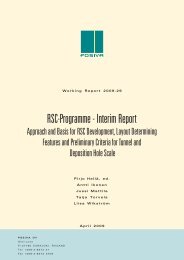Bentonite Mineralogy Part 1: Methods of Investigation - Posiva
Bentonite Mineralogy Part 1: Methods of Investigation - Posiva
Bentonite Mineralogy Part 1: Methods of Investigation - Posiva
You also want an ePaper? Increase the reach of your titles
YUMPU automatically turns print PDFs into web optimized ePapers that Google loves.
2 STRUCTURE AND CHEMICAL COMPOSITION OF CLAY MINERALS<br />
2.1 Structure <strong>of</strong> clay minerals<br />
5<br />
In this chapter, the structure <strong>of</strong> clay minerals is described. Without knowing the<br />
fundamental clay mineral structure it is not possible to understand many properties <strong>of</strong><br />
the different clay mineral species.<br />
Clay minerals are phyllosilicates, and their structure consists <strong>of</strong> two types <strong>of</strong> sheets:<br />
- Tetrahedral sheets (Fig. 2-1) consist <strong>of</strong> corner-linked tetrahedra with oxygens in the<br />
corners and cations (T) in the centre. Dominant cation is Si 4 +, but Ae+ is substituted<br />
for it frequently, up to half <strong>of</strong> the Si. Fe 3 + is substituted for Si 4 + occasionally; T/0<br />
ratio is T 20 5. The tetrahedra rest on a triangular face and share all three oxygens with<br />
three other tetrahedra. The sheet <strong>of</strong> linked tetrahedra has hexagonal symmetry. The<br />
fourth, apical, oxygen points in the figure downward from the base.<br />
- Octahedral sheets (Fig. 2-2) consist <strong>of</strong> edge-linked octahedra with OH in the corners<br />
and cations (R) in the centre. The cations are usually Al 3 +, Mg 2 +, Fe 2 + or Fe 3 +, but all<br />
other transition elements and Li are possible. The octahedral sheets can be described<br />
as composed <strong>of</strong> two planes <strong>of</strong> closest-packed hydroxyls with cations occupying the<br />
octahedral sites between the two planes.<br />
Figure 2-1. Tetrahedral sheet. The open circles are oxygens, the black circles<br />
tetrahedrally coordinated cations.<br />
Figure 2-2. Octahedral sheet. The filled black circles are OH:s and the filled grey<br />
circles octahedrally coordinated cations.

















